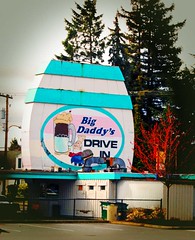Once upon a time Puget Sound had a lot more passenger rail. Trains ran hourly from downtown Seattle to downtown Tacoma. The Interurban line ran along what’s sort of the I-5 corridor these days. There was a street car that went up and down Queen Anne and another one that served West Seattle.
Rail travel was glam. No one expected to get from Seattle to LA or Chicago in less time than it takes to sit down to dinner – you booked a cabin and strolled to the dining car to eat off white linen and fell asleep to the melody of clacking rails. Oh, I’m sure you had to sit next to a young woman who, rather than talking on the phone to her whining boyfriend for the six hour trip, told you her tales of woe. Sure, there were hard luck types who’d scraped together the last of their cash to make the journey west seeking a better future, but in my unsophisticated imagination, rail travel wasn’t the second choice transportation it is to travelers today.
It’s the romance of rail – that and a crippling boredom from being cooped up in the house in this unseasonal squall – that sent us down to Auburn. The White River Valley Museum has a special exhibit going – “The Passenger Trains of Puget Sound” – about when rail still ruled. There’s a nice little collection of train photographs and memorabilia that can’t help but inspire nostalgia, even in those of us who didn’t live through the golden age of railway travel.
The permanent collection showcases the history of Auburn, once a lively farming and commercial town. Now there’s not much in the sad little downtown – it wasn’t quite deserted on this cold Sunday morning, but the obvious options were limited. It’s easy to blame the car for the death of little downtowns like this – once popular hubs died out as we decided to bypass them on the interstate. The docent at the museum said that given the price of gas, she reckoned we might see the rise of rail again – or some modern interpretation thereof – in the not so distance future.
 I enjoyed her optimism but I’m not sure we’re ready to give up the freedom of the open road for a more restrictive, slower, less independent manner of travel. Auburn itself is a fine example of what happened when we gave up trains for cars. There’s downtown with empty storefronts, easily reached on foot from the train station, a muddy swath of railyard, empty of passenger cars… and a little further out, close to the freeway offramp, two drive through espresso stands and and Big Daddy’s Drive In restaurant.
I enjoyed her optimism but I’m not sure we’re ready to give up the freedom of the open road for a more restrictive, slower, less independent manner of travel. Auburn itself is a fine example of what happened when we gave up trains for cars. There’s downtown with empty storefronts, easily reached on foot from the train station, a muddy swath of railyard, empty of passenger cars… and a little further out, close to the freeway offramp, two drive through espresso stands and and Big Daddy’s Drive In restaurant.
Related:
- Historic Passenger Trains Films DVD – we were hoping to see this at the museum but missed the screening.
- The Interurban on Seattle’s History Link
- The streetcar turnaround at West Seattle’s Alaska Junction
[tags]Auburn, 98002, train travel[/tags]

I could see the railways being rebuilt. Short-stay short-hop tourism is growing, replacing long-haul trips, which is best left to travel writers. People are concerned about higher fuel prices; changing work practices which means weekend breaks are more popular than long holidays; and they’re afraid of terrorism. You ain’t going to fly to Florida if you’re worried about the Florida Liberation Front kidnapping you.
Even the Irish copy-the-Yanks-at-all-costs government is rebuilding railroads that were built in the 1860s and shut down in the 1950s.
We could have expected that they would be more expensive to rebuild than to build and keep open.We’re just not quite sure why they are *slower* to rebuild, when they were built with picks and shovels in the 1860s and we have mechanical construction machines in Ireland today. Begorrah, we surely do.
Not as much cheap labor?
I was inspired by the idea of rail, that’s for sure. I’m looking into the cheap getaways on Amtrak.
Plus, our trains have awesome names. The Coast Starlight. The Empire Builder. And of course, The City of New Orleans.